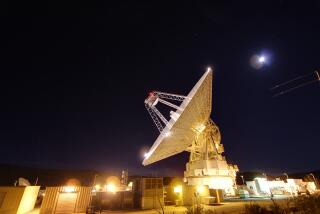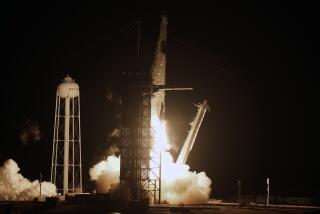GAO Shoots Holes in Plan for Deployment of Missile Defense System
WASHINGTON — A satellite surveillance system that is a key element of a national missile shield probably won’t meet its deployment schedule or cost targets and may have flaws that won’t be apparent until its satellites are in orbit, according to a government research agency.
The General Accounting Office said in a report issued this week that the Space-Based Infrared System Low is “at high risk of not delivering the system on time, at cost, or with expected performance.” The report recommends that the Pentagon revise the schedule of the program and consider other ways to accomplish its mission if it can’t be deployed on time.
Rep. Jerry Lewis (R-Redlands), chairman of the House Appropriations defense subcommittee and a strong supporter of missile defense, said Friday he has “grave concern” about the report’s findings.
The GAO report is a reminder that, despite considerable political pressure to quickly deploy an anti-missile shield, considerable technological hurdles must be crossed before a large-scale system can be deployed.
The infrared satellite system is in many ways the guts of the kind of national missile defense shield that the Bush administration wants to build.
In a large-scale attack, the system would find incoming warheads and decoys in mid-course and would beam tracking data to U.S. interceptor rockets to help them strike and destroy the enemy warheads.
The Pentagon has been trying to develop a system to accomplish this task since the mid-1980s. Yet many of the component technologies are not yet mature, the report said.
Congress made the challenge for the Pentagon much tougher by compressing the schedule, in its effort to deploy the shield as soon as possible. As currently planned, the Air Force would begin launching the system’s 24 satellites in 2006, with the full system deployed by 2010.
The system is expected to last until 2022 and to cost $11.8 billion in its lifetime.
To meet its schedule, the Air Force has decided to take the unusual step of beginning production while it is still developing the satellites. That means the program’s managers won’t have the results of an important flight test until more than five years after production is begun.
As a result, if the test shows design changes are needed, parts that have already been purchased based on the original design may become obsolete, “increasing program costs and causing schedule delays,” the report said.
The report noted that the Pentagon usually requires that software for a system be completed a year before the system is to be deployed. In this case, because the difficulty of the software development effort was originally underestimated, the software won’t be completed until three years after the first satellites are in orbit.
That “increases the risks that the software won’t be available when needed, or perform as required,” according to the report.
The GAO pointed out that the managers of the program have already concluded that five of six key technologies are so far from maturity that there is high risk that they won’t be ready when needed.
The national missile defense system developed under President Clinton’s administration, designed to protect the United States against only a handful of incoming warheads, did not require the use of the Space-Based Infrared System Low. But most missile defense advocates believe the country needs protection against attack by dozens of warheads or more.
And the infrared satellite system “is an unavoidable part of any missile defense shield that goes beyond the most rudimentary, basic threat,” said John Pike, a space and defense analyst at GlobalSecurity.org, a research organization in northern Virginia.
President Bush has said he is committed to developing a missile defense shield as soon as possible. But in recent years the Pentagon has struggled to develop several parts of its limited, ground-based system, including the booster for the interceptor missile and some features of the “kill vehicle” that the interceptor carries on its nose.
More to Read
Sign up for Essential California
The most important California stories and recommendations in your inbox every morning.
You may occasionally receive promotional content from the Los Angeles Times.











